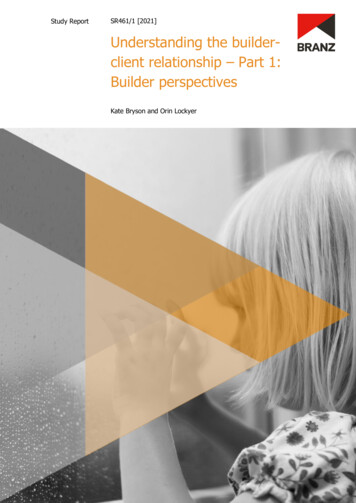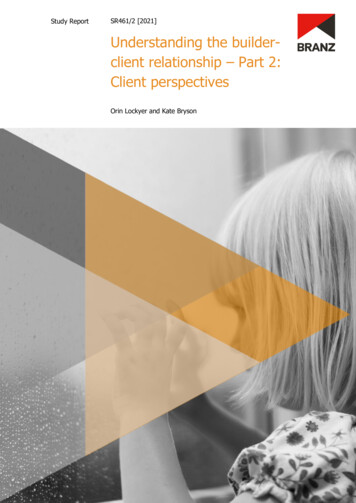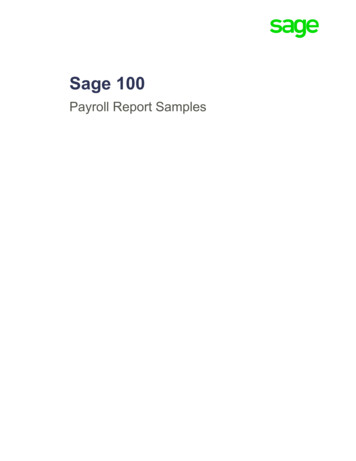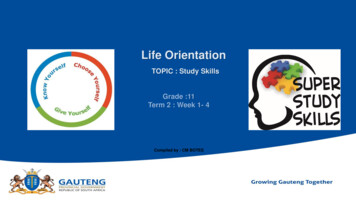
Transcription
Study ReportSR461/1 [2021]Understanding the builderclient relationship – Part 1:Builder perspectivesKate Bryson and Orin Lockyer
1222 Moonshine Rd, RD1, Porirua 5381Private Bag 50 908, Porirua 5240New Zealandbranz.nz BRANZ 2021ISSN: 1179-6197
Study Report SR461/1 Understanding the builder-client relationship – Part 1: Builder perspectivesPrefaceThis research was undertaken by Axon Consulting Limited in collaboration with BRANZ.This report is part 1 of a two-part research project that takes an in-depth look at bothsides of the builder-client relationship in an effort to understand what is and what isnot working for each party.AcknowledgementsWe would like to thank: our research partners Registered Master Builders Association (RMBA), New ZealandCertified Builders (NZCB), CHASNZ, and Switched On Group – we particularlyacknowledge the support of RMBA and NZCB who assisted us immensely withrecruitment of their members to participate in this researchthe residential builders who took the time to complete the surveythe residential builders and clients who volunteered to be interviewed and sharedtheir stories with us so that we could better understand the builder-clientrelationship.i
Study Report SR461/1 Understanding the builder-client relationship – Part 1: Builder perspectivesUnderstanding the builder-clientrelationship – Part 1: BuilderperspectivesBRANZ Study Report SR461/1AuthorsKate Bryson and Orin LockyerReferenceBryson, K. & Lockyer, O. (2021). Understanding the builder-client relationship – Part 1:Builder perspectives. BRANZ Study Report SR461/1. Judgeford, New Zealand: BRANZLtd.AbstractAnecdotally, the builder-client relationship has been a source of tension and stress forbuilders and clients. This research set out to investigate whether there was anyevidence to support these anecdotes and, if so, what impact it was having on thewellbeing of each party. This report describes the results of an online survey andinterviews with builders to understand the builder perspective of the relationship andits impact on builder mental health. Builders reported several tension points that causerelationship strain with clients and that client disagreements cause symptoms ofdepression and anxiety for some builders. Recommendations are made that focus onimproving communication and managing client expectations to avoid client conflictduring the build process. Further recommendations suggest greater mental healthsupport for residential builders.KeywordsResidential builder, build client, communication, relationship, conflict, mental health,wellbeing.ii
Study Report SR461/1 Understanding the builder-client relationship – Part 1: Builder perspectivesContentsEXECUTIVE SUMMARY. 11.INTRODUCTION . 42.METHODOLOGY . 6Scope .6Definitions .6Approach .62.3.1 Surveys .72.3.2 Interviews .93.RESULTS. 11Demographics and industry background . 11Communication with clients – when and how? . 15Working with clients – the tension points . 19Working with clients – the rewards . 38Disagreements with clients and their impact . 43Mental health impacts of builder-client conflict . 47A comment about COVID-19 . 524.DISCUSSION AND RECOMMENDATIONS. 53Communication demands . 54Tension points . 54The impact of disagreements . 57Concluding comments. 58Limitations of the research . 59Summary of recommendations . 60REFERENCES . 61APPENDIX A: BUILDER SURVEY . 62APPENDIX B: BUILDER INTERVIEW SCHEDULE . 68APPENDIX C: THEMES IDENTIFIED FROM BUILDER AND CLIENTINTERVIEWS . eFigureFigureFigureFigure1. Age of participants (n 195). . 112. Gender of participants (n 195). . 123. Regions where participants built (n 195). . 124. Years worked in residential building (n 195). . 125. Industry organisation membership (n 195). . 136. Main role of participant (n 195). . 147. Business ownership (n 195). . 148. On or off the tools (n 195). . 149. Frequency of communication with client (n 195). . 1510. Builder communication methods (n 195). . 1611. Number of communication channels used by builders (n 195). . 16iii
Study Report SR461/1 Understanding the builder-client relationship – Part 1: Builder perspectivesFigure 12. Proportion of builders dealing with clients outside business hours (n 195).17Figure 13. Frequency of dealing with clients outside business hours (n 161). . 18Figure 14. Frequency of dealing with clients during the weekend (n 161). . 18Figure 15. Clients often have unrealistic expectations of their builder (n 195). . 20Figure 16. There is very little trust in the builder-client relationship (n 195). . 24Figure 17. Clients do not trust builders to get the job done (n 195). . 26Figure 18. Builders must communicate with clients so much that it is slowing down thebuild process (n 195). . 26Figure 19. Clients want to know about everything that happens on site (n 195). . 28Figure 20. Clients seem to be asking increasingly complex and technical questionsabout their build (n 195). . 29Figure 21. The leaky building crisis has made clients more anxious about the buildprocess (n 195). . 30Figure 22. Builders are having to manage client frustrations about the consentingprocess (n 195). . 30Figure 23. Clients hold all the power in the builder-client relationship (n 195). . 31Figure 24. A client will only be dissatisfied if the builder isn’t doing their job properly(n 195). . 33Figure 25. There are some clients that are never satisfied (n 195). . 33Figure 26. Some clients can be aggressive in how they communicate (n 195). . 34Figure 27. If I lose sleep at night over work, it’s usually because of an issue with aclient (n 195). . 35Figure 28. If I am stressed out about an issue with a client, it affects the quality of mywork (n 195). . 36Figure 29. Dealing with clients is the most stressful part of my job (n 195). . 36Figure 30. When I get together with other builders, we often find ourselves venting orcomplaining about our clients (n 195). 37Figure 31. When I see a client is trying to get hold of me, I start to feel anxious(n 195). . 37Figure 32. I am open to new ways of dealing with “tricky” clients (n 195). 38Figure 33. When the relationship with the client is good, the job is more enjoyable(n 195). . 38Figure 34. Working with clients is one of the most rewarding parts of the job (n 195).39Figure 35. The majority of my clients are great, and I enjoy working with them(n 195). . 40Figure 36. Clients are usually really grateful for the work I do for them (n 195). . 40Figure 37. I find the more I communicate with my clients the happier they are with thebuild (n 195). . 41Figure 38. I look forward to giving clients updates about their build (n 195). . 42Figure 39. Have you ever had a serious disagreement with a client? (n 195). . 43Figure 40. I have considered changing jobs due to the stress of a disagreement with aclient (n 145). . 43Figure 41. Following a disagreement with a client I have lacked the motivation tocontinue with the build (n 145). . 44Figure 42. Client disagreements are so distracting that they affect my ability to worksafely (n 145). . 45iv
Study Report SR461/1 Understanding the builder-client relationship – Part 1: Builder perspectivesFigure 43. Have you ever found yourself so distracted by a client disagreement thatyou had an accident on site? (n 145). . 45Figure 44. In the past I have been able to resolve disagreements with clientssuccessfully (n 145). . 46Figure 45. I have had a disagreement with a client that has negatively impacted mymental health. For example, I felt anxious or depressed about what washappening (n 145). . 47Figure 46. Proportion of builders at each depression mean scale score during clientconflict situation (n 145). . 48Figure 47. Proportion of builders at each anxiety mean scale during client conflictsituation (n 145). . 49v
Study Report SR461/1 Understanding the builder-client relationship – Part 1: Builder perspectivesExecutive summaryThe mental health and wellbeing of construction industry workers has been in thespotlight in recent years after the publication of Bryson and Duncan’s (2018) report onmental health in the construction industry. In that study, representatives from acrossthe industry acknowledged that the mental health of the workforce was in desperateneed of support. Since then, organisations and businesses in the industry haveredoubled their work to raise awareness around mental health for people working inconstruction.This research moves beyond describing the mental health crisis for the industrytowards investigating the factors that may be contributing to it. Anecdotal stories frombuilders and clients have suggested that the builder-client relationship could be onecause of significant distress for both parties during residential house builds. This studyset out to investigate if there was any evidence to support these anecdotes and, if so,what impact builder-client relationship tension is having on the wellbeing of each party.This research examined both sides of the relationship, but this report describes thebuilder’s perspective. The findings relating to clients are reported in BRANZ StudyReport SR461/2 (Lockyer & Bryson, 2021), a separate report entitled Understandingthe builder-client relationship – Part 2: Client perspectives.Research questions Is the builder-client relationship a significant cause of stress for residentialbuilders?If so, what factors contribute to the builder-client relationship problems and howprevalent are they?MethodsThis research used a mixed-methods approach – 195 builders responded to an onlinesurvey, and 19 took part in semi-structured telephone interviews. A combination ofquantitative and qualitative data is used to measure the prevalence and describe thetension points that lead to builder-client conflict. Measures of mental health outcomeswere also used to test whether disagreements with clients had any impact on buildermental health.ResultsThe results of this research fall into three areas: Communication demands on builders.Tension points during the build process.The impact of disagreements on builder wellbeing.The theme that runs throughout the findings is communication. Conflict anddisagreements very often emerged when the client’s expectations were not met.Builders described how clear, honest and early communication could assist withmanaging client expectations and reducing the risk of disagreements.Communication demandsThe communication demand on builders appears to be high. The majority of buildersreported communicating with clients outside normal business hours and in weekends,using multiple communication channels. It was often accepted by builders that this was1
Study Report SR461/1 Understanding the builder-client relationship – Part 1: Builder perspectivesa necessary part of the job. Some builders described putting some professionalboundaries in place to manage this, while others felt they needed to be available at alltimes.Tension pointsSeveral tension points were identified as potential causes of conflict between buildersand clients. Tension points lead to conflict when the client’s expectations around themare not met or were mismanaged: Site visits: Client access to site was a source of conflict. Site visits were alsodescribed as providing an opportunity for disagreements over other issues to dowith the build that the client might identify while on site.Variations: Builders reported that sometimes clients do not understand theimplications of a variation to the original plan and that this can at times lead todisagreements.Budget: Builders said that client disagreements about unexpected costs orchanges to the budget were common. Clients withholding payments due todisputes was a significant cause of distress for builders.Building defects: Builders described clients as having a low tolerance for defectsand that this can lead to disagreements.Delays: Builders acknowledged that clients were often unhappy about delaysduring the build, and this could be a catalyst for conflict.The impact of disagreements on builder mental wellbeingThree-quarters of builders had experienced a serious client disagreement. Of those,more than half experienced moderate to high symptoms of depression and anxiety.Builder-client disagreements appear to have a detrimental effect on builder mentalhealth. In the interviews, builders described client conflicts impacting on their familiesand their personal wellbeing. The level of distress experienced by builders during clientdisagreements was significant and should provide the motivation to industry to developsolutions to reduce builder-client relationship problems.RecommendationsManaging the relationship with the clientThe Building Together resource should be developed – a proposed workbook thatwould guide builders and clients through an early conversation about how they willwork together throughout the building process. It is suggested it could provide spaceto record what has been agreed between the builder and client and should function asa mutually agreed code of conduct.As a starting point, the areas covered in this resource should include: when and how a builder can be contactedthe frequency and duration of site visitssupervision during site visitshealth and safety requirements at site visitsinteractions with subcontractors or other tradespeople on sitedefect identification processesother tension points identified by clients in the client perspectives report (Lockyer &Bryson, 2021).2
Study Report SR461/1 Understanding the builder-client relationship – Part 1: Builder perspectivesThe development of the Building Together resource should be done in consultationwith residential builders and clients. This should be done via facilitated workshops orfocus groups where these research findings are presented to builders and clients toprovide further input on the format, structure and content of the resource.Supporting builder mental health and wellbeingEducation should be made available for builders around managing their work-lifebalance to encourage better professional boundaries and greater investment in selfcare. The ways in which this kind of information is delivered should be informed bybuilders. It is suggested that builders be consulted about this at the same workshopsor focus groups convened for the Building Together resource.Existing mental health help options within and outside the industry should continue tobe promoted and supported.Residential building leadership organisations should prioritise the development ofmental health and wellbeing programmes that work well in a residential buildingcontext.3
Study Report SR461/1 Understanding the builder-client relationship – Part 1: Builder perspectives1.IntroductionThe mental health and wellbeing of construction industry workers has been in thespotlight in recent years after the publication of Bryson and Duncan’s (2018) report onmental health in the construction industry. In that study, representatives from acrossthe industry acknowledged that the mental health of the workforce was in desperateneed of support. Since then, the industry has been mobilised into action with manyorganisations and businesses working to increase awareness around mental health andthe MATES in Construction suicide prevention programme launching in 2019.While work is under way to support construction industry workers who are in distress,the authors of this research frequently engaged in conversations with industrystakeholders wanting to understand why the problem was happening in the first place.Many offered theories. One hypothesis repeatedly suggested by those working in theresidential building sector was that significant stress is induced for builders when therelationship with the client deteriorates. This issue was repeatedly raised by builders,so an informal process of stakeholder engagement was undertaken with members ofthe residential building industry. The goal of this engagement was to verify whetherthis was a problem worthy of further investigation. Stakeholders consulted included allthe research partners listed in the acknowledgements for this report, other residentialbuilders known to the researchers and the Mental Health in Construction StrategyGroup led by CHASNZ.During this stakeholder engagement, a shift was noted regarding what the industrywanted from research in this field. Stakeholders expressed a desire to move beyonddescribing the problem towards investigating the causes. This shift from researchfocusing on what the problem looks like to what is causing it is a natural progressiontowards answering the question “How do we fix it?” Stakeholders were clear that, ifdistress related to builder-client conflict is a contributing factor to poorer builderwellbeing, the research must identify solutions and a way forward, not just describethe problem.At the same time, BRANZ was undertaking research investigating client experiences ofbuilding a new home (Lockyer & Marston, 2020). Clients described some of thedifficulties they encountered when trying to understand the building process. In thisstudy, there was evidence that the client’s relationship with the builder was negativelyimpacted when their lack of building knowledge and poor communication from theirbuilder led to unmet expectations. The relationship with the builder was identified asan important factor in quality building outcomes. This work focused on the clientexperience and build quality but did not consider the builder’s perspective or wellbeingoutcomes of the builder-client relationship.To the best of our knowledge, no previous research has been done to investigate theinterpersonal aspects of the builder-client relationship or its impact on the wellbeing ofeither party. As a result, this research is exploratory in nature. It seeks to investigatewhether there is any evidence to support the anecdotal stories shared during theperiod of stakeholder engagement with industry. More specifically, this study aims toassess whether the builder-client relationship is a source of stress for builders and, ifbuilder-client relationship stress does exist, to measure its impact on builder mentalwellbeing. The results of this research will be used to make recommendations andinform solutions, if any are required.4
Study Report SR461/1 Understanding the builder-client relationship – Part 1: Builder perspectivesThe client perspective of the builder-client relationship was also investigated as part ofthis research, and findings are presented in a separate report (Lockyer & Bryson,2021). Together, these reports look to provide a detailed explanation of the builderclient relationship from both perspectives. The goal of this research is to describe bothsides of the builder-client relationship – not to attribute blame to either party but tounderstand the perspectives of both. This will enable us to identify ways of supportingbuilders and clients to work together in a healthy way that supports their wellbeing andbetter building outcomes.Research questions Is the builder-client relationship a significant cause of stress for residentialbuilders?If so, what factors are contributing to the builder-client relationship problems andhow prevalent are they?5
Study Report SR461/1 Understanding the builder-client relationship – Part 1: Builder perspectives2.MethodologyScopeThis study investigates the relationship between residential builders in New Zealandand their clients. The study used quantitative online surveys and qualitative interviewsof both builders and clients to understand the prevalence and impact of builder-clientdisagreements on builder mental health and client satisfaction. The methods describedhere were undertaken for both builders and clients. This report describes the results ofthe builder survey and interviews.The commercial building sector was not included in this study as their clients andprocurement and project management processes are different to those of theresidential builder. This study focuses on the interpersonal relationship betweenindividual builders and their clients.DefinitionsFor the purposes of this research, the term ‘builder’ is used to describe the personacting on behalf of the company that constructed the home for the client. In mostcases, this is the person building the house, but in some cases, it will be a projectmanager or sales representative. A detailed breakdown of the roles represented by theterm ‘builder’ is provided in the results section.The term ‘client’ is used to describe the people who engaged the builder to build thema house. This excludes developers.The ‘builder-client relationship’ is the term used to describe the way builders andclients worked together as people. There is a distinction here between the legal orcontractual relationship each party had entered into and the way they interacted witheach other throughout the building process. The builder-client relationship referred toin this report means the interpersonal relationship between the individuals involved inthe build.ApproachThe methods described here were undertaken for both builders and clients. This reportdescribes only the results for builders. Results for the client study are published in aclient perspectives report (Lockyer & Bryson, 2021).This study utilised a mixed-methods approach. Online surveys were used to gatherquantitative data from builders about their experiences dealing with clients.At the end of the survey, participants were invited to be interviewed about theirexperience, and qualitative data was collected to give the quantitative findings greatercontext.The results of both approaches are reported together. Each survey finding is presentedalong with interview excerpts that help to further explain the dynamics of therelationship and put the survey data into context.The goal of this study together with the client perspectives study is to describe bothsides of the builder-client relationship and to measure the prevalence of issues6
Study Report SR461/1 Understanding the builder-client relationship – Part 1: Builder perspectivespreviously only described anecdotally. This research will inform initiatives to assistbuilders to better manage builder-client relationships.2.3.1SurveysThe builder survey was designed to gather quantitative data to measure whetherbuilder-client relationship tension was an issue, to identify possible causes of theconflict if any existed and to understand how this conflict impacted the mentalwellbeing of builders.The survey was run in February and early March 2020. The data collection period forthe survey was cut short due to the COVID-19 Alert Level 4 and 3 lockdown. Theresearch team decided that it was inappropriate to continue with recruitment given theimpact the pandemic response was having on the industry. Additionally, reactions tothe lockdown may have skewed responses to the survey and impacted our results. Theshortened data collection phase did impact sample size. However, enough data hadbeen gathered to allow for meaningful descriptive analysis. Confidence in thequantitative data is further strengthened by the addition of the qualitative findings. Thecombination of these two data sources ensures the results of this study are reliabledespite the smaller than expected sample.The survey was delivered online using Qualtrics survey software.The builder survey consisted of several sections. All the questions in the survey arepresented in Appendix A.The first section asked about demographic information and industry experience.Builders were asked about: their agetheir genderwhat region they worked inlength of time in the industrytheir role in residential buildingwhether they own the business they work for.The second section asked builders about the amount and kind of communication theyhad with clients. Builders were asked about: how often they dealt with clientswhat communication channels they usedhow frequently they dealt with clients outside normal business hours.The third section presented a variety of statements about the builder-client relationshipand builders were asked to select how much they agreed or disagreed using theoptions ‘strongly disagree’, ‘disagree’, ‘neither agree nor disagree’, ‘agree’ or ‘stronglyagree’. This section measured the prevalence of builder-client relationship problemsand tested whether anecdotal stories were real phenomena. Statements about thenegative aspects of the builder-client relationship were balanced with statements aboutthe rewarding aspects. Example statements from this section of the surveys: Dealing with clients is the most stressful part of my jobWorking with the client is one of the most rewarding parts of the jobSome clients can be aggressive in how they communicateClients are usually really grateful for the work I do for them7
Study Report SR461/1 Understanding the builder-client relationship – Part 1: Builder perspectives When I see a client is trying to get hold of me, I start to feel anxiousThe majority of my clients are great and I enjoy working with themThe fourth section examined the impact of serious client disagreements on builders’job satisfaction, wellbeing and workplace safety. Builders were asked if they had everhad a serious disagreement with a client, and those who had were asked whether theyagreed or disagreed with a series of statements that measured the impact thatdisagreement had on them. The same response options were given as those in theprevious section of the survey. Example statements from this section of the survey: I have had a disagreement with a client that has negatively impacted my mentalhealth. For example, I felt anxious or depressed about what was happeningClient disagreements are so distra
Bryson, K. & Lockyer, O. (2021). Understanding the builder-client relationship - Part 1: Builder perspectives. BRANZ Study Report SR461/1. Judgeford, New Zealand: BRANZ Ltd. Abstract Anecdotally, the builder-client relationship has been a source of tension and stress for builders and clients.










